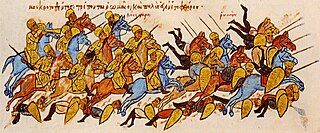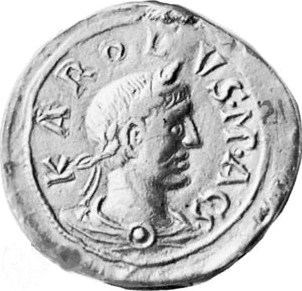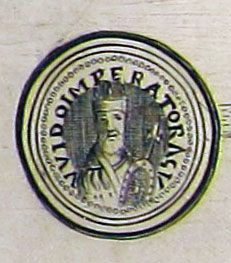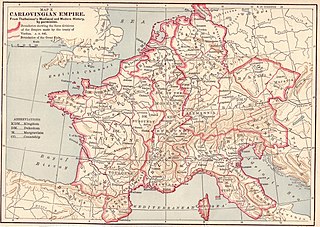Related Research Articles

Arnulf of Carinthia was the duke of Carinthia who overthrew his uncle, Emperor Charles the Fat, became the Carolingian king of East Francia from 887, the disputed King of Italy from 894 and the disputed Holy Roman Emperor from February 22, 896 until his death at Regensburg, Bavaria.
The 890s decade ran from January 1, 890, to December 31, 899.

Year 896 (DCCCXCVI) was a leap year starting on Thursday of the Julian calendar.

Charles III, also known as Charles the Fat, was the emperor of the Carolingian Empire from 881 to 888. A member of the Carolingian dynasty, Charles was the youngest son of Louis the German and Hemma, and a great-grandson of Charlemagne. He was the last Carolingian emperor of legitimate birth and the last to rule over all the realms of the Franks.

King of Italy was the title given to the ruler of the Kingdom of Italy after the fall of the Western Roman Empire. The first to take the title was Odoacer, a barbarian military leader, in the late 5th century, followed by the Ostrogothic kings up to the mid-6th century. With the Frankish conquest of Italy in the 8th century, the Carolingians assumed the title, which was maintained by subsequent Holy Roman Emperors throughout the Middle Ages. The last Emperor to claim the title was Charles V in the 16th century. During this period, the holders of the title were crowned with the Iron Crown of Lombardy.
Aribo was margrave of the Carolingian March of Pannonia from 871 until his death. He is recognised as a progenitor of the Aribonid dynasty.

Berengar I was the king of Italy from 887. He was Holy Roman Emperor between 915 and his death in 924. He is usually known as Berengar of Friuli, since he ruled the March of Friuli from 874 until at least 890, but he had lost control of the region by 896.

Guy III of Spoleto was the margrave of Camerino from 880 and then duke of Spoleto and Camerino from 883. He was crowned king of Italy in 889 and emperor in 891. He died in 894 while fighting for control of the Italian Peninsula.
Liutward was the archchancellor of the Carolingian Empire from 878 and the bishop of Vercelli from 880 by appointment of Charles the Fat. Never liked by the nobility, he was trusted by Charles as a confidant and go-between with the papacy.
The March of Ivrea was a large frontier county in the northwest of the medieval Italian kingdom from the late 9th to the early 11th century. Its capital was Ivrea in present-day Piedmont, and it was held by a Burgundian family of margraves called the Anscarids. The march was the primary frontier between Italy and France and served as a defense against any interference from that state.
Anscar I was the margrave of Ivrea from 888 to his death. From 877 or 879, he was the count of Oscheret in Burgundy. He supported Guy III of Spoleto for the throne of France after the deposition of Charles the Fat in 887, but after Guy's failed attempt and the coronation of Odo, he returned with Guy across the Alps, where the duke was elected King of Italy. In gratitude, he created the March of Ivrea in the northeast and invested his Burgundian supporter.
Wilhelminer War was a minor war fought in the March of Pannonia from 882 to 884. It was initially a rebellion of the sons of the margraves William II and Engelschalk I, led by Engelschalk II, against the new margrave Aribo. Svatopluk I of Great Moravia intervened as an ally of Aribo because he had been at war with William and Engelschalk when the two died in 871. The "Wilhelminers" were the descendants of William I of the Traungau, father of the two late margraves.

The March of Friuli was a Carolingian frontier march, established in 776 as the continuation of the Lombard Duchy of Friuli, established against the Slavs and Avars. It was ceded to the Duchy of Bavaria as the March of Verona in 952. Its territory comprised parts of modern-day Italy, Slovenia and Croatia.
Bernard or Bernhard was the only child of Emperor Charles the Fat. He was born of an unknown concubine and was thus considered illegitimate. Charles tried to make him his heir, but failed in two attempts.

The March of Carinthia was a frontier district (march) of the Carolingian Empire created in 889. Before it was a march, it had been a principality or duchy ruled by native-born Slavic princes at first independently and then under Bavarian and subsequently Frankish suzerainty. The realm was divided into counties which, after the succession of the Carinthian duke to the East Frankish throne, were united in the hands of a single authority. When the march of Carinthia was raised into a Duchy in 976, a new Carinthian march was created. It became the later March of Styria.
Liutbert was the Archbishop of Mainz from 863 until his death. He also became Abbot of Ellwangen in 874 and is reckoned the first Archchancellor of Germany. He was one of the major organisers—along with Henry of Franconia—of the vigorous and successful defence of East Francia against Viking attack during his last decade.
Wibod was the Bishop of Parma from 855 until his death. He was, during the reigns of Louis II, Carloman, Charles III, and Berengar I, the most important power-broker in Emilia.
Geilo was the Bishop of Langres from 880 until his death. His episcopate coincided mostly with the emperorship of Charles the Fat and after 885 he is a leading ecclesiastical figure at the imperial court. Geilo increased the landholdings and comital rights of the diocese of Langres immensely in his short tenure, a sign of political sagacity. Geilo has been painted as a villain, an ambitious prelate trying to extend his see's temporal authority as far as it could go under the reign of weak Carolingians.

The Siege of Asselt was a Frankish siege of the Viking camp at Asselt in the Meuse valley in the year 882. Though the Vikings were not forced by arms to abandon their camp, they were compelled to come to terms whereby their leader, Godfrid, was converted to Christianity.
References
- Reuter, Timothy (trans.) The Annals of Fulda . (Manchester Medieval series, Ninth-Century Histories, Volume II.) Manchester: Manchester University Press, 1992.
- MacLean, Simon. Kingship and Politics in the Late Ninth Century: Charles the Fat and the end of the Carolingian Empire. Cambridge University Press: 2003.